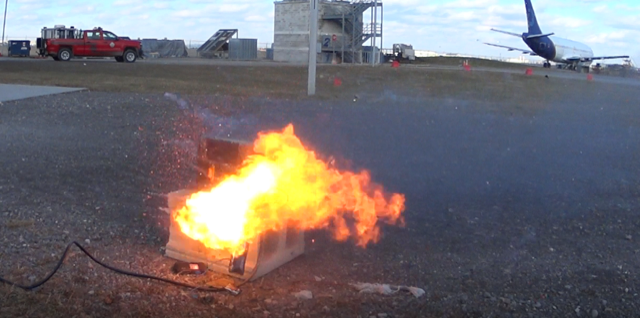Estimated reading time 5 minutes, 42 seconds.
It was rather like watching a pot of water coming to a boil, but when the cell phone finally ignited, the violence of the fire was unmistakable.

By the time the scorching, smoky blaze had been extinguished by an airport firefighter, there was nothing left of the hapless electronic device.
The controlled experiment took place on Dec. 8 at Pearson Airport’s Fire and Emergency Services Training Institute (FESTI), where media and other industry representatives were invited to see the demonstration of a new product that developers say will change firefighting protocols on board aircraft.
The Explorer Group (through its subsidiary Advanced Fire Solutions) and Dupré Minerals of Staffordshire, England, were in Toronto to promote Aqueous Vermiculite Dispersion (AVD), a product manufactured from the naturally occurring mineral vermiculite, which was originally developed to combat high intensity magnesium fires.
Ultimately, researchers at Dupré discovered the mixture was effective on three additional types of fires, including those caused by lithium-ion batteries, Class A combustibles (paper, textiles, plastics), and Class C energized electrical fires.
AVD contains vermiculite, a burn-resistant, flaky mineral that puffs up when heated. Given the widespread public association of vermiculite with asbestos, Dupré is quick to point out that its material is sourced from the world’s two purest mines and multiple tests are performed on every batch to ensure there is no asbestos content.
Billed as environmentally friendly, AVD has undergone three years of in-house testing and independent verification. Now, it will be rolled out to the North American market as a series of fire extinguishers (under the trade names LithEx and LithOut) and as an AVD bulk agent for engineered fire suppression systems.
Growing concern
According to Consumer Reports in June 2017, there is a lithium battery fire on board a U.S. aircraft about once every 10 days. In 2016, the Federal Aviation Administration (FAA) reported a total of 31 incidents, and numbers are on the rise.

It’s not hard to see why. With each passenger now bringing along multiple devices powered by these rechargeable batteries, the risk is increasing. Add to that the fact that many airlines are now keeping several rentable iPads together in storage cabinets, and it becomes likely that airline crews will need to deal with such fires at some point in their careers.
When they enter a condition called “thermal runaway,” lithium-ion batteries can ignite in a white hot blaze that emits toxic fumes. That can occur when chemicals in a battery’s cells, separated by a permeable membrane, are allowed to mix. This could be caused by damage or defect, but the end result is energy overload, which leads to the rupture and ignition of the battery.
Up to this point, airline crews have been equipped with standard Halon and ABC fire extinguishers, neither of which has proven effective against lithium battery fires. Most airlines instruct their crews to use water and non-alcoholic liquids to help suppress these fires. Some have taken it a step further, providing special containment devices–pouches into which a burning device can be inserted with the help of goggles and heat-resistant gloves.
However, the makers of AVD promise it will deliver a new level of fire suppression. Applied as a fine mist, the water content helps to rapidly cool a lithium battery fire while the vermiculite particles form an oxygen barrier snuffing out the fire source and stopping re-ignition.
Later, the resulting crust can be even be scraped up without risk of re-ignition, a common concern with lithium-ion battery fires.
While AVD’s manufacturers are currently working with Underwriters Laboratories of Canada (ULC) to test and certify the product, Jody Smyth, president of The Explorer Group, said this is a lengthy process. In the meantime, some Canadian users are utilizing AVD as a “best practice” solution–in other words, their insurance companies have approved its carriage as long as the airline is compliant with all traditional fire extinguisher regulations.
“We recommend an approach that includes an AVD extinguisher as well as a fire resistant containment device,” said Smyth, following the demonstration at FESTI. He added that bespoke solutions can be customized for individual operators.
While an AVD extinguisher currently has a certified shelf life of three years, Dupré is expecting to extend that to five years as further testing progresses.
AVD is available in several dispenser types: portable, backpack and trolley extinguishers; fire service pump systems; and fixed installations.
Click below to see a comparison of AVD mist and water applied to a lithium-ion battery fire.








